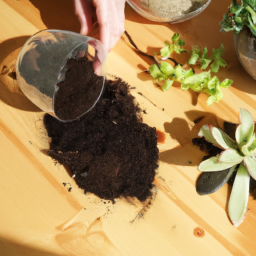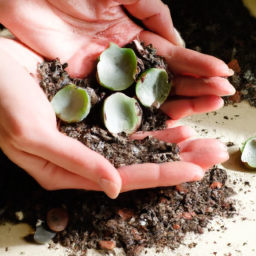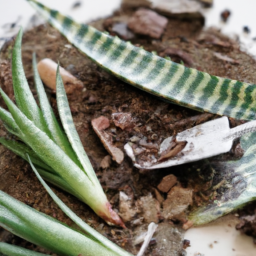
Succulents have become increasingly popular as indoor houseplants due to their unique shapes and low maintenance requirements. One key factor in successfully growing succulents indoors is choosing the right soil. In this blog post, we will explore the best soil for succulents indoors to help you keep your plants healthy and thriving. Whether you’re a seasoned succulent enthusiast or just starting out, understanding the importance of soil composition is essential for the long-term health of your indoor succulent garden. So, let’s dive in and learn more about the best soil for succulents indoors.
Benefits of Using Well-Draining Soil for Indoor Succulents
Why Well-Draining Soil is Essential for Succulents
When it comes to growing succulents indoors, the type of soil you use plays a crucial role in the overall health and well-being of your plants. Succulents are known for their ability to store water in their leaves and stems, making them drought-resistant plants. However, this also means that they are susceptible to root rot if their soil retains too much moisture. This is why using well-draining soil is essential for succulents, as it allows excess water to flow through the soil and prevents waterlogged conditions that can lead to root rot.
Well-draining soil is typically a mix of materials such as sand, perlite, and pumice, which help create air pockets in the soil and allow water to drain quickly. This type of soil mimics the natural habitat of succulents, which are often found in arid regions with sandy or rocky soil that drains well. By using well-draining soil, you can create an environment that closely resembles the conditions in which succulents thrive in nature, promoting healthy root growth and preventing water-related issues.
In addition to preventing root rot, well-draining soil also helps improve aeration and nutrient uptake for succulents. The presence of air pockets in the soil allows oxygen to reach the roots, which is essential for respiration and overall plant health. Furthermore, well-draining soil allows for better nutrient absorption, as excess water is able to drain out of the soil, preventing nutrient buildup that can harm the roots of succulents. Overall, using well-draining soil can help ensure that your indoor succulents receive the proper balance of water, air, and nutrients they need to thrive.
How to Create Your Own Well-Draining Soil Mix
Creating a well-draining soil mix for your indoor succulents is easy and can be done using a few simple ingredients. Start by gathering the following materials: potting soil, coarse sand, perlite, and pumice. Potting soil provides the base for your mix, while coarse sand helps improve drainage and aeration. Perlite is a lightweight volcanic rock that helps prevent soil compaction and improves drainage, while pumice is a porous volcanic rock that helps retain moisture while still allowing for drainage.
To create your well-draining soil mix, combine equal parts potting soil, coarse sand, perlite, and pumice in a large container. Mix the ingredients together thoroughly, ensuring that the soil is well-blended and all components are evenly distributed. You can adjust the ratio of each ingredient based on the specific needs of your succulents, but a good starting point is a 1:1:1:1 ratio of potting soil, sand, perlite, and pumice.
Once you have created your well-draining soil mix, you can use it to repot your indoor succulents or plant new ones. Make sure to choose pots with drainage holes to further promote good drainage and prevent water from collecting at the bottom of the pot. When repotting your succulents, gently remove them from their current pot, shake off any excess soil, and plant them in the new well-draining soil mix. Water the plants lightly after repotting and allow the soil to dry out completely before watering again.
Tips for Maintaining Healthy Succulents with Well-Draining Soil
In addition to using well-draining soil, there are a few tips you can follow to ensure that your indoor succulents thrive in their new environment. First, make sure to place your succulents in a location with plenty of bright, indirect sunlight, as most succulents require at least 6 hours of sunlight per day to thrive. Avoid placing them in direct sunlight, as this can cause sunburn and damage the leaves of the plants.
Second, water your succulents sparingly and allow the soil to dry out completely between waterings. Succulents are adapted to survive in dry conditions and prefer to be underwatered rather than overwatered. Using well-draining soil can help prevent overwatering, but it is still important to monitor the moisture levels in the soil and adjust your watering schedule accordingly.
Lastly, fertilize your succulents sparingly, as they are not heavy feeders and can be easily damaged by too much fertilizer. Use a balanced fertilizer diluted to half strength and apply it to your succulents during the growing season, typically in spring and summer. Avoid fertilizing during the winter months when succulents are dormant, as they do not require as many nutrients during this time.
By following these tips and using well-draining soil, you can create a healthy environment for your indoor succulents to thrive and enjoy their unique beauty. Remember to monitor your plants regularly, adjust your care routine as needed, and enjoy the satisfaction of growing beautiful succulents in your home.

Top Soil Mixtures for Succulents in Indoor Environments
The Importance of Choosing the Right Soil for Succulents
When it comes to growing succulents indoors, one of the most important factors to consider is the type of soil you use. Succulents have unique needs when it comes to soil, as they require a well-draining mixture that allows air to circulate around their roots. Using the wrong type of soil can lead to root rot and other issues that can harm your plants.
There are many different soil mixtures available for succulents, but not all of them are created equal. Some are too dense and hold onto moisture, while others are too sandy and don’t provide enough nutrients for your plants. It’s important to choose a soil mixture that is specifically designed for succulents and their unique needs.
By selecting the right soil mixture for your indoor succulents, you can help ensure that they thrive and grow healthy and strong. In this guide, we will explore some of the top soil mixtures for succulents in indoor environments and discuss the benefits of each.
Choosing the Best Soil Mixtures for Succulents
When it comes to choosing the best soil mixtures for succulents, there are a few key factors to consider. First and foremost, you want to look for a soil mixture that is well-draining and allows water to flow through it easily. This will help prevent overwatering and ensure that your succulents’ roots stay healthy and dry.
Another important factor to consider is the nutrient content of the soil mixture. Succulents don’t require a lot of nutrients to thrive, but they do need some to support their growth. Look for a soil mixture that contains a balanced blend of nutrients, such as nitrogen, phosphorus, and potassium, to help your succulents grow strong and healthy.
Finally, consider the texture of the soil mixture. Succulents prefer soil that is loose and well-aerated, as this allows air to circulate around their roots and helps prevent root rot. Look for a soil mixture that is light and fluffy, with a good balance of organic matter and inorganic materials.
Top Soil Mixtures for Succulents in Indoor Environments
One of the best soil mixtures for succulents in indoor environments is a blend of potting soil, perlite, and sand. This mixture provides excellent drainage and aeration, while also providing the nutrients that succulents need to thrive. To create this mixture, combine equal parts potting soil, perlite, and sand in a large container and mix well before planting your succulents.
Another great soil mixture for indoor succulents is a blend of cactus soil, perlite, and pumice. Cactus soil is specifically designed for succulents and provides excellent drainage, while perlite and pumice help aerate the soil and prevent compaction. To create this mixture, combine equal parts cactus soil, perlite, and pumice in a large container and mix well before planting your succulents.
For succulents that require a more sandy soil mixture, consider using a blend of succulent soil, sand, and gravel. This mixture provides excellent drainage and aeration, while also mimicking the natural environment of many succulents. To create this mixture, combine equal parts succulent soil, sand, and gravel in a large container and mix well before planting your succulents.

Tips for Choosing the Best Soil for Succulents in Indoor Settings
Understanding the Needs of Succulents
Succulents are unique plants that have adapted to survive in arid environments by storing water in their leaves, stems, and roots. This means that they have specific needs when it comes to soil. The best soil for succulents in indoor settings is one that is well-draining, as these plants are prone to root rot if their roots sit in water for too long.
When choosing soil for your indoor succulents, look for a mix that is specifically designed for cacti and succulents. These mixes are usually made up of a combination of materials such as sand, perlite, and peat moss, which help to improve drainage and aeration. Avoid using regular potting soil, as it tends to hold onto water and can lead to overwatering and root rot.
Another important factor to consider when choosing soil for your indoor succulents is pH level. Succulents prefer slightly acidic soil with a pH level between 5.5 and 6.5. You can test the pH of your soil using a soil pH meter, which can be found at most gardening stores. If the pH of your soil is too high, you can lower it by adding sulfur or peat moss.
Choosing the Right Soil Mix
When it comes to choosing a soil mix for your indoor succulents, there are a few options to consider. One popular choice is a mix of equal parts potting soil, perlite, and coarse sand. This mix provides good drainage and aeration, which are essential for the health of your succulents.
Another option is to use a commercial cactus and succulent mix, which is specially formulated to meet the needs of these plants. These mixes are usually made up of a combination of materials such as sand, perlite, and peat moss, which help to improve drainage and aeration.
If you prefer to make your own soil mix, you can experiment with different combinations of materials until you find one that works best for your succulents. Just make sure to avoid using regular potting soil, as it tends to hold onto water and can lead to overwatering and root rot.
Tips for Maintaining Healthy Soil
Once you have chosen the best soil for your indoor succulents, it is important to take steps to maintain its health. One way to do this is by repotting your succulents every year or two. This helps to refresh the soil and prevent it from becoming compacted, which can impede drainage and aeration.
Another tip for maintaining healthy soil is to avoid overwatering your succulents. These plants are adapted to survive in dry conditions, so they do not need to be watered as frequently as other houseplants. Make sure to allow the soil to dry out completely between waterings, and always water from the bottom to prevent water from pooling around the roots.
Finally, consider adding a layer of gravel or small rocks to the top of the soil in your succulent containers. This helps to prevent moisture from evaporating too quickly and can also add a decorative touch to your indoor garden. Just make sure to avoid covering the entire surface of the soil, as this can prevent air from reaching the roots of your succulents.
Essential Points
When it comes to growing succulents indoors, choosing the right soil is key to their success. Succulents have specific needs when it comes to soil, as they require good drainage to prevent root rot. The best soil for succulents indoors is a well-draining mix that allows water to flow through easily, while also retaining some moisture to keep the roots hydrated.
A good soil mix for succulents typically includes a combination of potting soil, perlite, and coarse sand. These ingredients help create a loose, well-aerated soil that allows excess water to drain away quickly. It’s important to avoid using regular garden soil, as it tends to hold onto water and can lead to root rot in succulents. By using the right soil mix, you can provide your indoor succulents with the perfect growing environment to thrive and flourish.
Your Burning Questions Answered:
Q1. What is the best type of soil for indoor succulents?
A1. The best soil for indoor succulents is a well-draining mix that is specifically formulated for cacti and succulents. This type of soil will prevent overwatering and root rot, which are common issues with succulents grown indoors.
Q2. Can I use regular potting soil for my indoor succulents?
A2. Regular potting soil is not recommended for indoor succulents because it tends to retain too much moisture, which can lead to root rot. It is best to use a well-draining succulent soil mix to ensure the health and longevity of your plants.
Q3. Where can I purchase the best soil for indoor succulents?
A3. You can purchase the best soil for indoor succulents at your local garden center, nursery, or online. Look for a cactus and succulent soil mix that is specifically designed to provide the proper drainage and aeration that these plants require.
Q4. How often should I repot my indoor succulents with fresh soil?
A4. It is recommended to repot your indoor succulents with fresh soil every 1-2 years, or when you notice that the soil has become compacted or waterlogged. Repotting will help ensure that your plants have access to the nutrients they need to thrive.
Q5. Can I add perlite or sand to regular potting soil to make it suitable for indoor succulents?
A5. While adding perlite or sand to regular potting soil can improve drainage, it is still not recommended for indoor succulents. It is best to use a pre-made succulent soil mix to ensure the proper balance of nutrients and drainage for your plants.

James Wong is a renowned ethnobotanist, plant scientist, and local television presenter. With a passion for demystifying plant science, he is known for translating complex botanical concepts into practical advice for everyday plant enthusiasts. James’s expertise spans from traditional gardening to cutting-edge plant technologies, making his insights accessible and informative.


